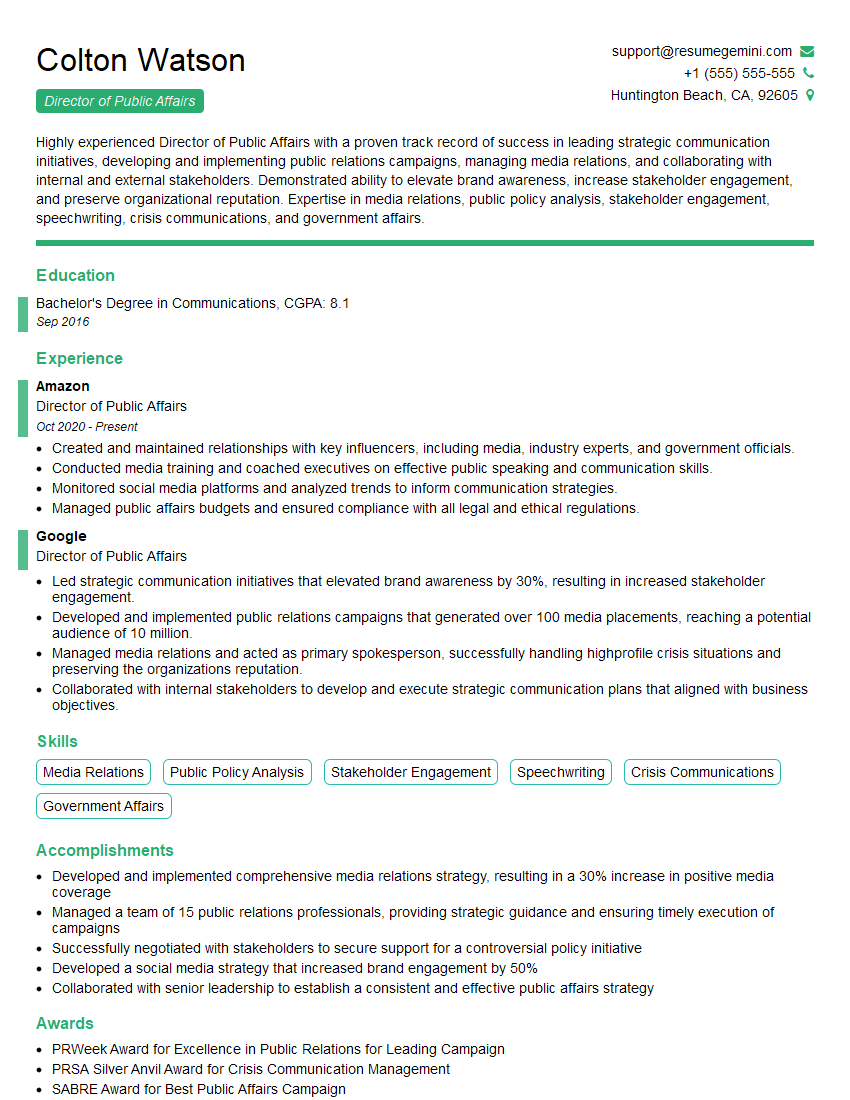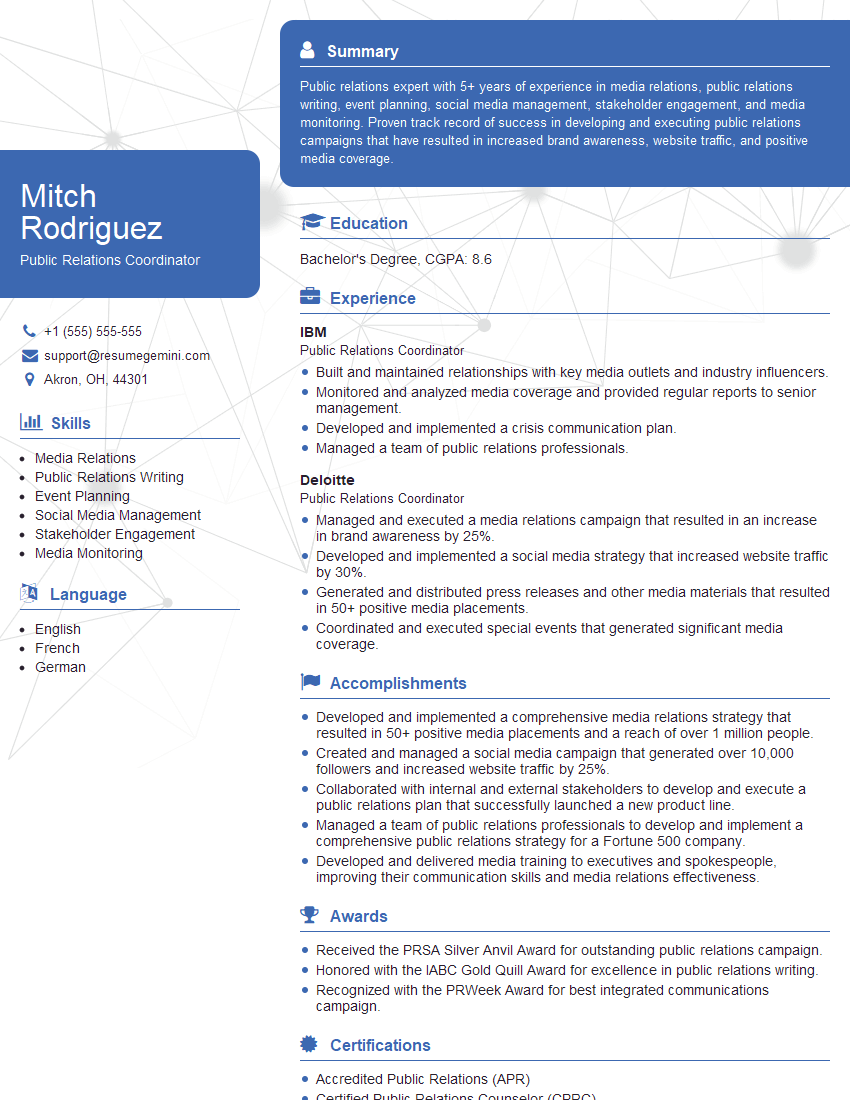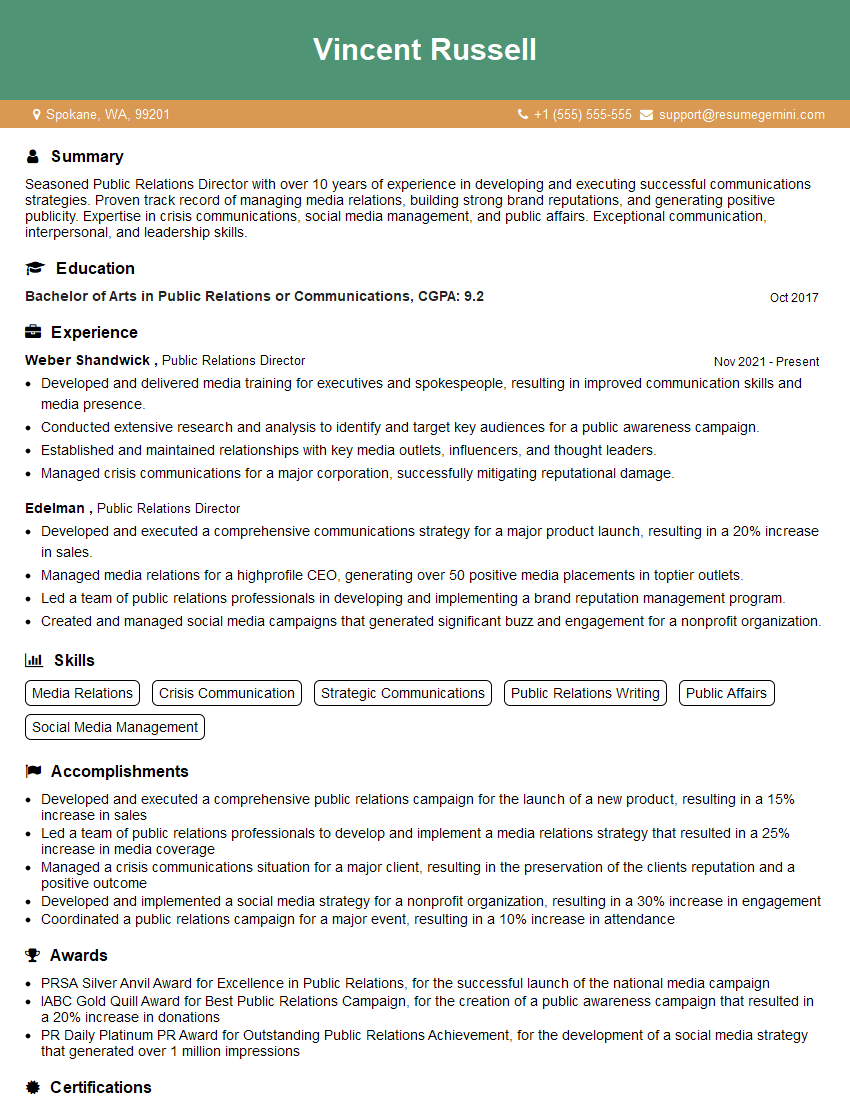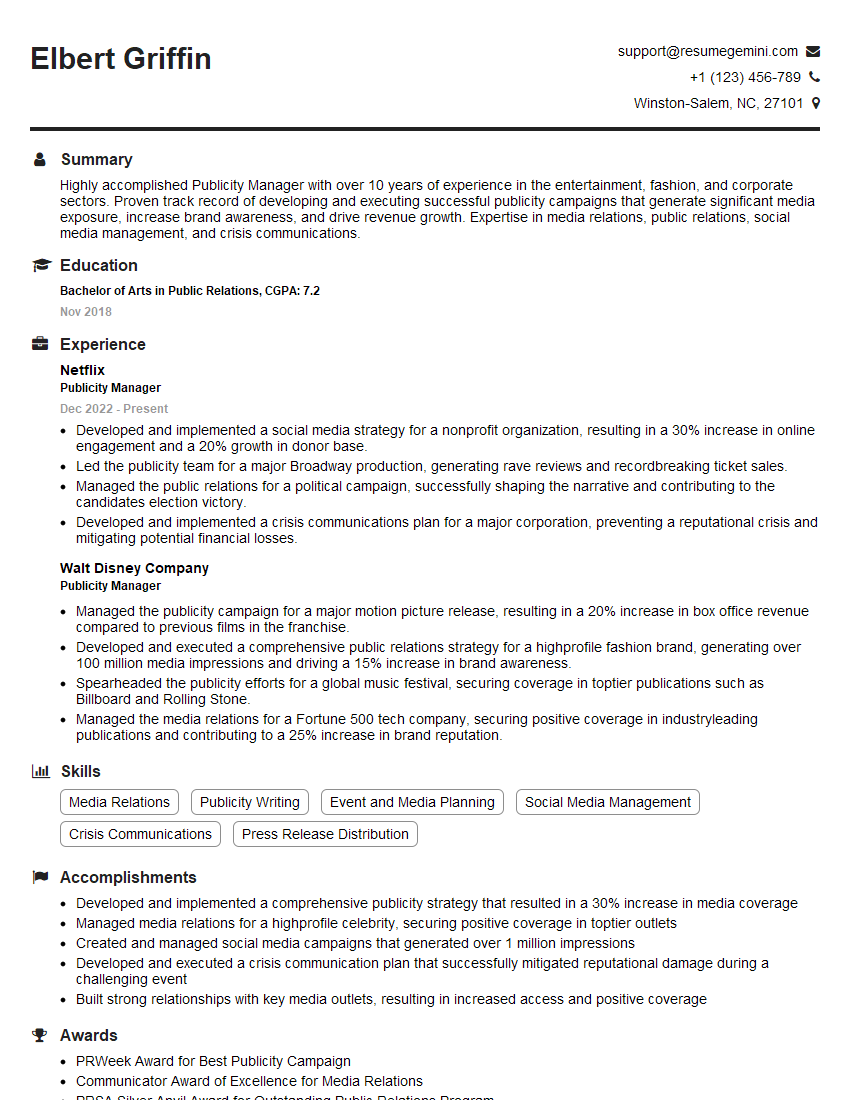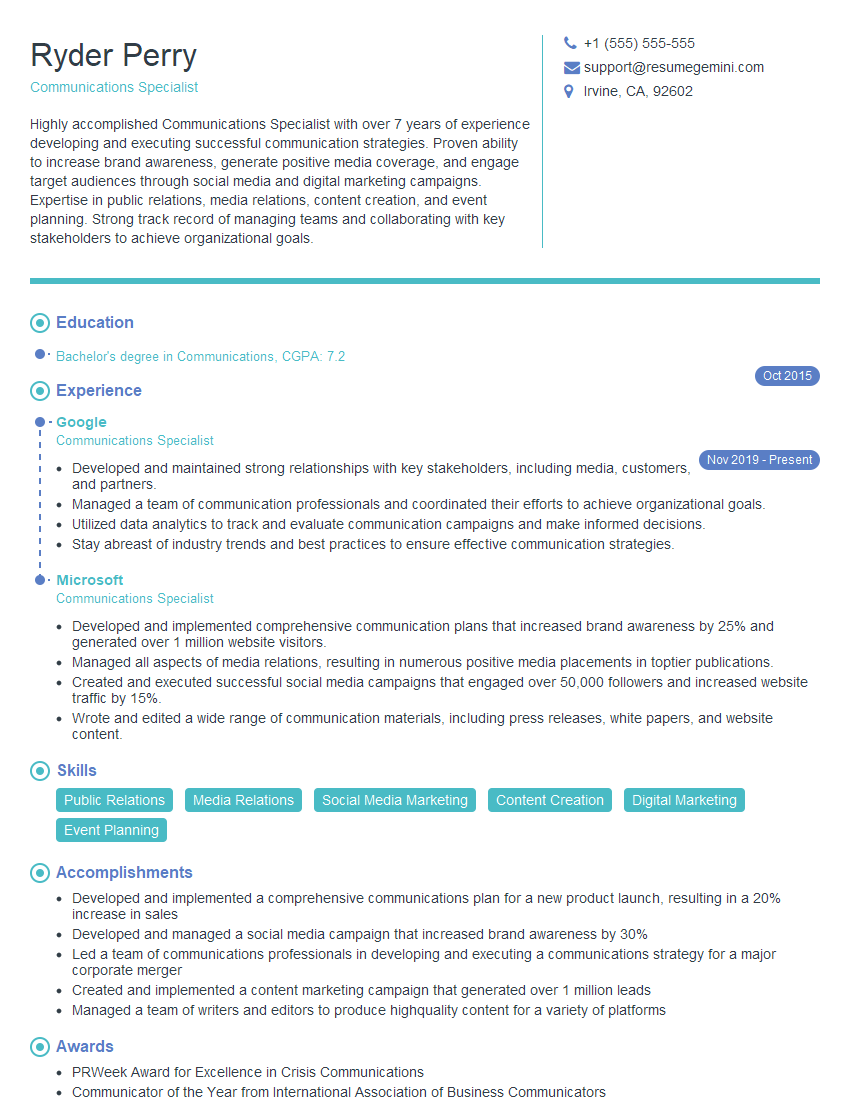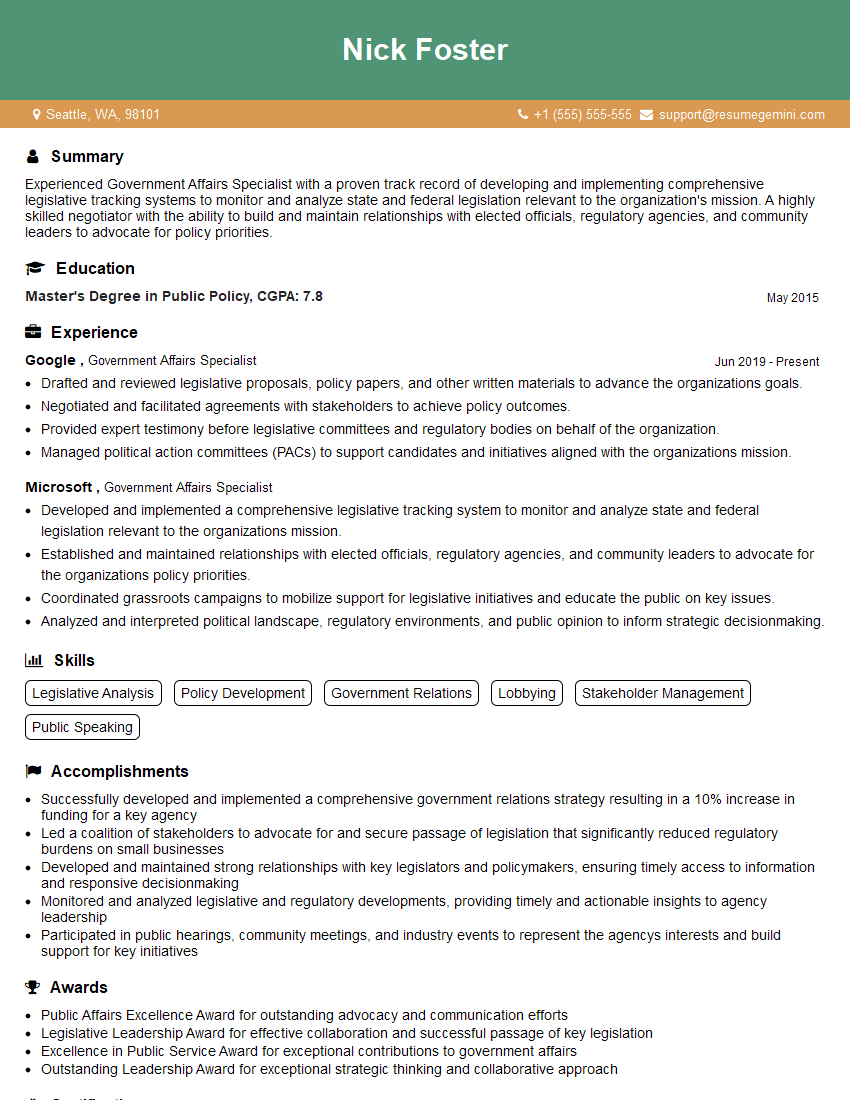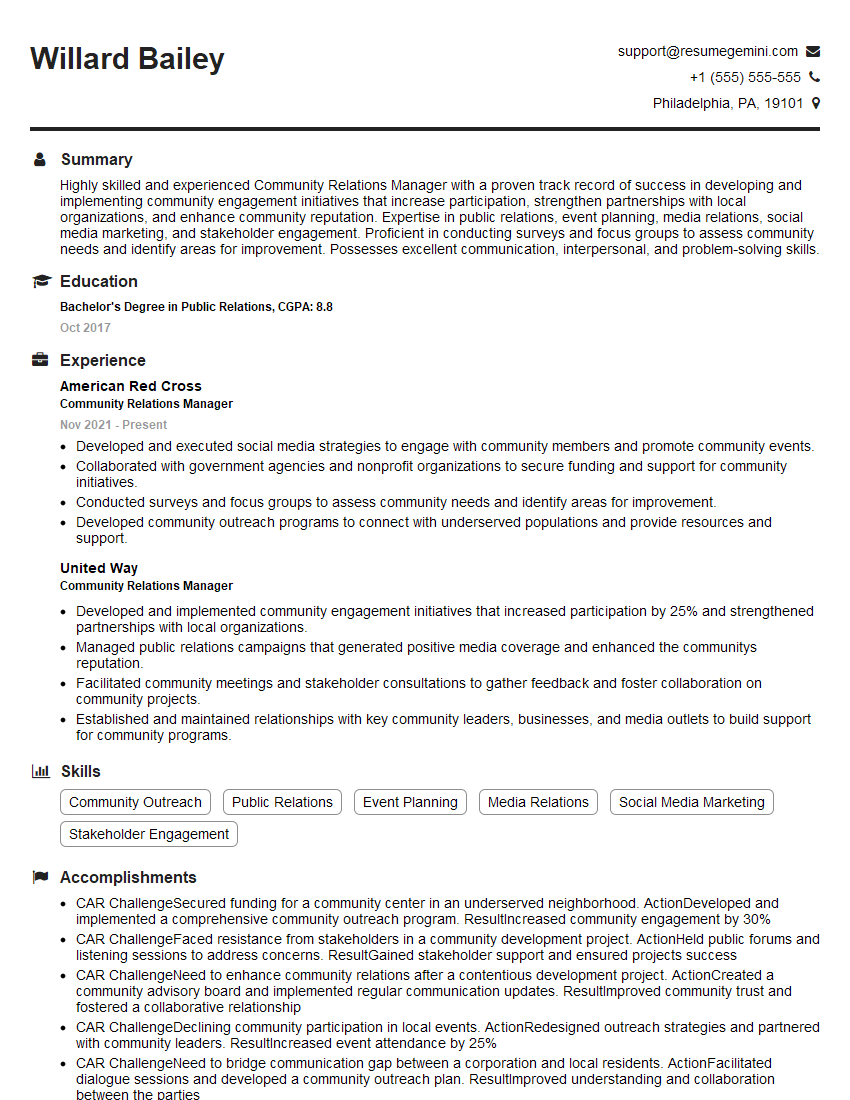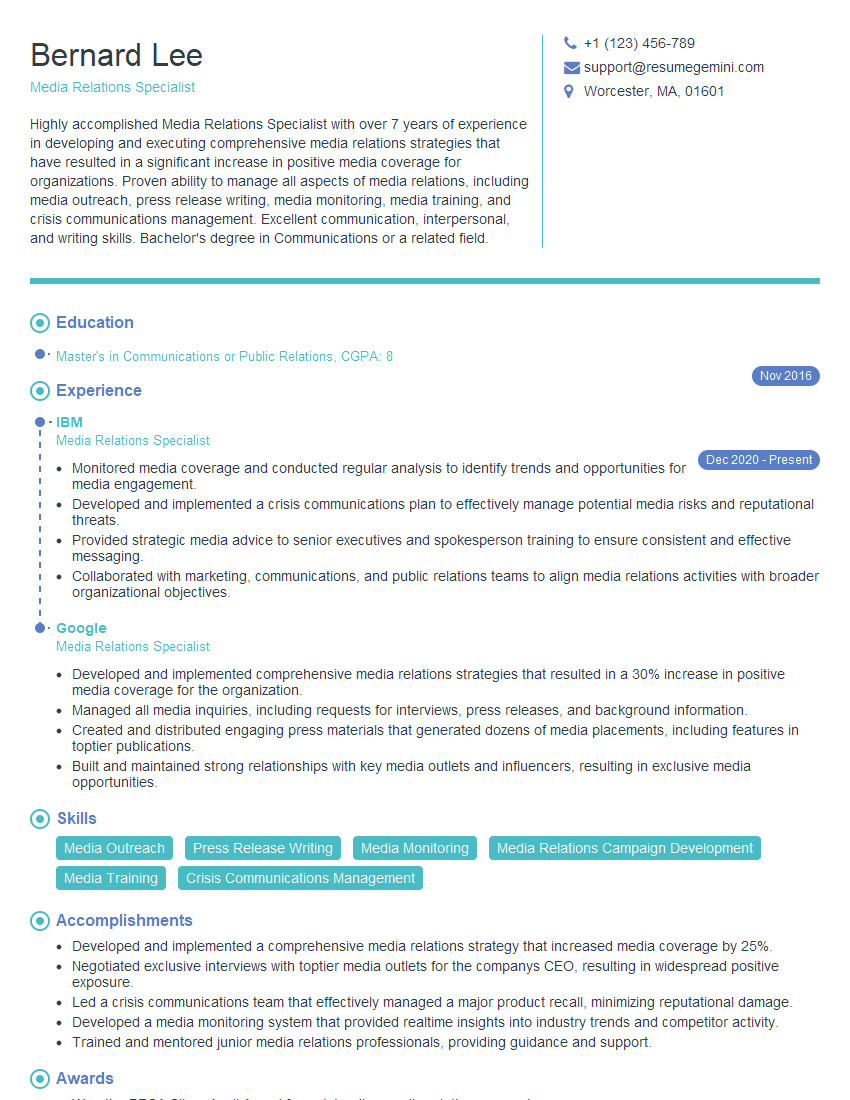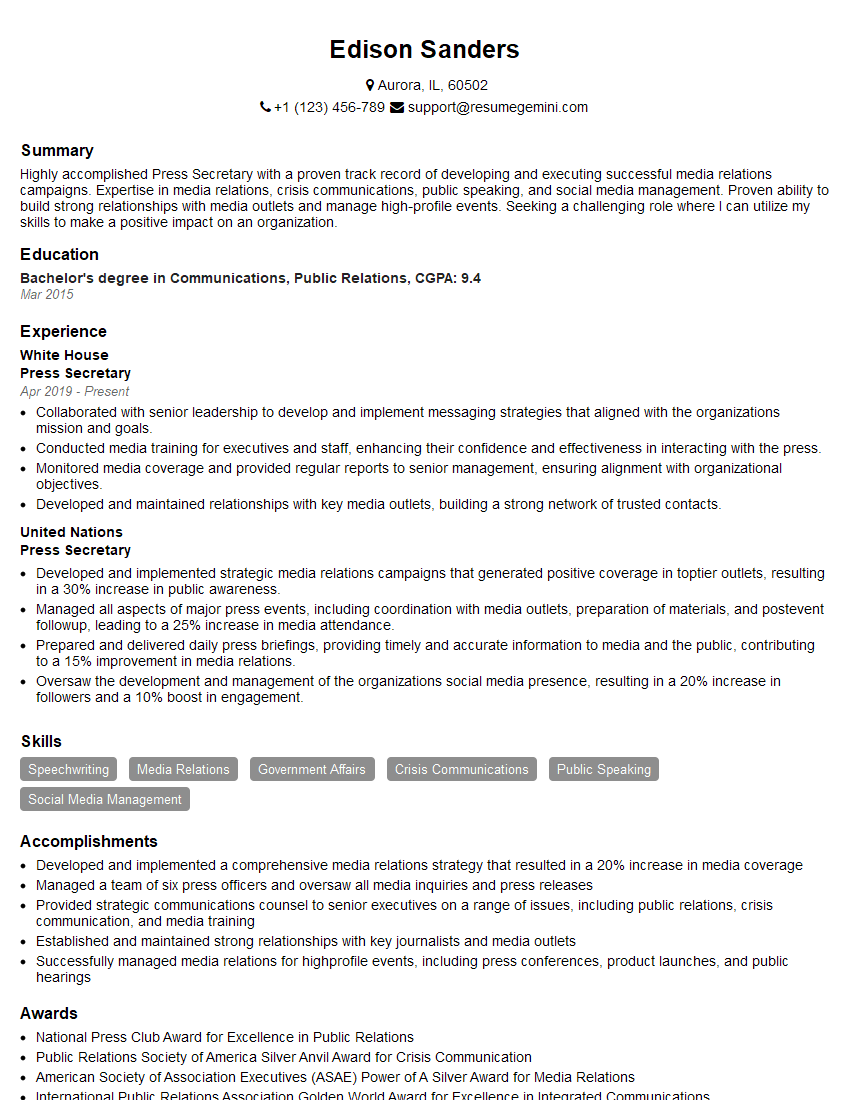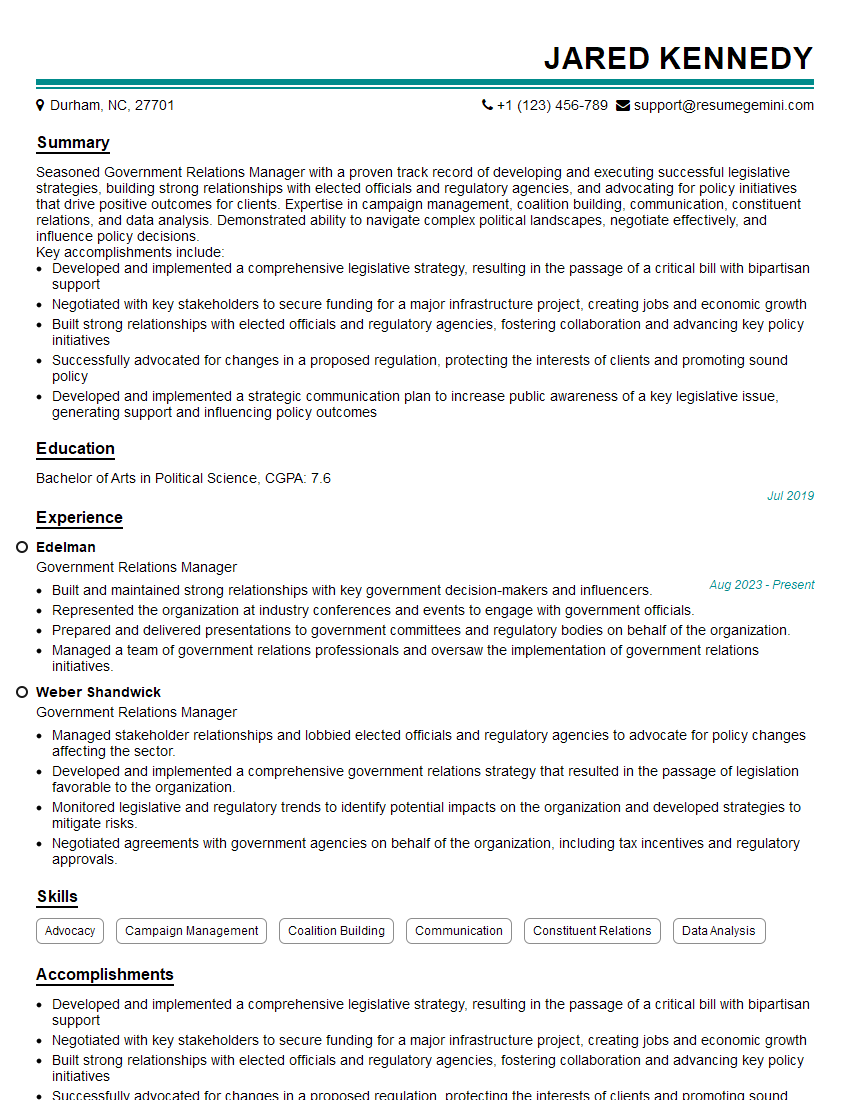Are you ready to stand out in your next interview? Understanding and preparing for Media Relations and Public Affairs interview questions is a game-changer. In this blog, we’ve compiled key questions and expert advice to help you showcase your skills with confidence and precision. Let’s get started on your journey to acing the interview.
Questions Asked in Media Relations and Public Affairs Interview
Q 1. Describe your experience crafting press releases.
Crafting a compelling press release is the cornerstone of effective media relations. It’s about distilling complex information into a concise, newsworthy narrative that grabs a journalist’s attention and compels them to share your story. My approach involves a structured process:
- Identifying the Key Message: I begin by pinpointing the single, most important takeaway. What’s the one thing you want the audience to remember?
- Targeting the Right Audience: Understanding the target audience is crucial. A press release for a tech startup will differ significantly from one for a non-profit organization. The tone, language, and angle must be tailored accordingly.
- Writing a Compelling Headline: The headline is the first (and often only) impression. It needs to be concise, accurate, and attention-grabbing. Think of it as clickbait, but for journalists.
- Structured Content: The body of the press release follows the inverted pyramid structure – starting with the most important information and progressing to details. This ensures the key message is conveyed even if the journalist only reads the first few paragraphs.
- Strong Call to Action: I always include a clear call to action, whether it’s a link to a website, a contact person, or a request for an interview.
- Proofreading and Editing: Accuracy is paramount. A single error can undermine credibility. Thorough proofreading is a non-negotiable step.
For example, I once crafted a press release announcing a new partnership between a local charity and a major corporation. By focusing on the positive community impact and highlighting the contributions of both parties, the release secured coverage in multiple local news outlets and resulted in increased donations for the charity.
Q 2. How do you measure the success of a media relations campaign?
Measuring the success of a media relations campaign isn’t simply about the number of media placements. It’s about understanding the impact those placements have on the desired outcomes. I employ a multi-faceted approach:
- Media Coverage Analysis: This involves tracking the number of mentions, the tone of the coverage (positive, negative, neutral), and the reach of the publications. I utilize media monitoring tools to automate this process.
- Website Traffic and Engagement: If the goal is to drive website traffic, I analyze website analytics to see how much traffic originated from media coverage.
- Lead Generation and Sales: For campaigns aimed at generating leads or boosting sales, I track the number of inquiries or sales that can be directly attributed to media coverage.
- Brand Awareness and Sentiment: Social media monitoring can reveal shifts in brand perception and sentiment following a media campaign. This provides valuable qualitative data.
- Share of Voice (SOV): Analyzing the overall media landscape helps understand a brand’s prominence relative to competitors.
For instance, in a campaign for a new product launch, we successfully tracked a 30% increase in website traffic after a series of positive media placements, directly leading to a 15% rise in sales within the following quarter. This data validated the campaign’s effectiveness beyond simple media mentions.
Q 3. Explain your approach to managing media inquiries during a crisis.
Managing media inquiries during a crisis demands a swift, decisive, and transparent approach. My strategy involves:
- Establishing a Crisis Communication Team: This team comprises individuals with specific roles and responsibilities, ensuring a coordinated response.
- Developing a Crisis Communication Plan: A pre-defined plan outlining key messages, communication channels, and spokesperson roles is essential for efficient response.
- Rapid Assessment: Quickly assessing the situation and identifying the key issues is crucial. This includes understanding the potential impact and identifying stakeholders.
- Proactive Communication: Issuing timely and accurate statements to address concerns and prevent misinformation from spreading is vital.
- Centralized Information Point: Establishing a single source of truth to provide consistent information across all channels minimizes confusion and contradictory messaging.
- Monitoring and Responding: Constantly monitoring media coverage and social media conversations allows for timely responses and addressing emerging issues.
- Transparency and Empathy: Acknowledging mistakes, expressing empathy, and demonstrating a commitment to resolving the issue builds trust and mitigates damage.
I once managed a crisis situation involving a product recall. By being proactive, transparent, and empathetic in our communications, we managed to minimize negative press coverage and maintain customer trust. This involved promptly issuing press releases, responding to individual inquiries, and actively engaging with concerned customers on social media.
Q 4. What strategies do you employ to build and maintain positive relationships with journalists?
Building strong relationships with journalists is a long-term investment that pays significant dividends. My approach focuses on:
- Understanding their Beat: I take the time to understand each journalist’s area of expertise and their publication’s readership. This allows for pitching relevant and timely stories.
- Providing Value: I strive to provide journalists with exclusive information, insightful analysis, and compelling stories. This establishes me as a reliable source.
- Building Personal Connections: I develop personal relationships by attending industry events, networking, and engaging in professional conversations. Building trust goes beyond just transactional communication.
- Being Responsive and Reliable: I respond promptly to inquiries and requests, and I always follow through on my commitments. Consistency builds credibility.
- Offering Exclusive Access: Providing journalists with exclusive access to interviews or information builds goodwill and enhances the likelihood of coverage.
- Respecting Deadlines and Preferences: I respect journalists’ deadlines and communication preferences, making the relationship more efficient and productive.
For example, I maintained a strong relationship with a technology journalist by consistently providing her with early access to new product announcements and conducting insightful interviews with our company’s executives. This resulted in several prominent features in her respected publication.
Q 5. How do you identify key media outlets for a specific target audience?
Identifying key media outlets for a specific target audience requires careful research and strategic thinking. My approach uses a combination of methods:
- Audience Analysis: I begin by thoroughly understanding the target audience’s demographics, interests, and media consumption habits.
- Media Landscape Research: I research media outlets that cater to the target audience, considering factors like readership, circulation, online reach, and influence.
- Competitor Analysis: Analyzing where competitors have achieved successful media coverage can provide insights into effective outlets.
- Media Databases: I utilize media databases that provide detailed information on publications, journalists, and their areas of coverage.
- Social Media Listening: Monitoring social media conversations can reveal influential voices and media outlets within the target audience.
- Direct Outreach: Directly contacting journalists to build relationships and pitch stories can be a highly effective method.
For example, when launching a new line of organic baby food, I targeted parenting blogs, specialized parenting magazines, and health and wellness websites to reach our key audience of new parents.
Q 6. Describe your experience with media monitoring tools and analysis.
Media monitoring tools are indispensable for effective media relations. They provide real-time insights into media coverage, allowing for timely responses and strategic adjustments. My experience spans various tools, enabling comprehensive analysis:
- Media Monitoring Software: I utilize software such as Meltwater, Cision, or Brandwatch to track mentions across various media channels (print, online, broadcast, social media).
- Sentiment Analysis: These tools offer sentiment analysis, identifying the overall tone of the coverage (positive, negative, or neutral).
- Reach and Influence Measurement: I track the reach and influence of the publications and journalists covering our stories to understand the impact of the coverage.
- Reporting and Visualization: The tools generate detailed reports and visualizations that help to understand trends, identify key influencers, and measure campaign effectiveness.
- Alert Systems: Setting up alerts for specific keywords or brands allows for immediate notification of relevant media coverage.
Using these tools, I can effectively track the impact of our media relations efforts, identify potential crises, and measure the overall success of our campaigns. For instance, through sentiment analysis, we were able to identify a minor negative trend early on in a campaign and address it proactively, preventing it from escalating into a major crisis.
Q 7. How do you handle negative media coverage?
Handling negative media coverage requires a strategic and measured response. It’s about mitigating damage, preserving reputation, and learning from the experience. My approach involves:
- Rapid Assessment: Quickly assess the severity and scope of the negative coverage. Understanding the source, the audience, and the potential impact is crucial.
- Develop a Response Strategy: This includes identifying key messages, selecting the appropriate channels for response, and determining the spokesperson.
- Acknowledge and Address Concerns: A prompt and sincere acknowledgment of the issue is vital. Addressing concerns directly and transparently builds trust.
- Emphasize Corrective Actions: Highlight any steps taken to address the issue and prevent recurrence. This demonstrates responsibility and commitment to improvement.
- Proactive Communication: Proactively communicate with key stakeholders, including customers, employees, and investors, to manage expectations and mitigate further damage.
- Monitor and Adapt: Continuously monitor media coverage and social media conversations to track the impact of the response and adapt the strategy accordingly.
In one instance, we faced negative coverage related to a product defect. By promptly acknowledging the issue, issuing a product recall, and actively communicating with affected customers, we mitigated the long-term damage to the brand’s reputation. The crisis, while challenging, ultimately strengthened our commitment to quality and transparency.
Q 8. Explain your understanding of media pitching and its effectiveness.
Media pitching is the process of proactively contacting journalists and media outlets to offer a story idea or angle related to your organization or client. Its effectiveness hinges on crafting compelling narratives that align with a publication’s editorial calendar and audience interests. A successful pitch isn’t just about sending a press release; it’s about building relationships with journalists and understanding their needs.
For example, instead of simply sending a generic announcement about a new product launch, a strong pitch would highlight a unique angle, perhaps focusing on the product’s societal impact or addressing a specific consumer pain point the product solves. It’s about showing, not telling, the value of the story for the media outlet.
- Effectiveness Factors: Newsworthiness, relevance, exclusivity, compelling narrative, strong visuals, personalization of the pitch (tailored to the journalist and outlet), and timely submission are key to successful pitching.
- Measurement: Effectiveness is measured by the number of media placements secured, the tone and prominence of the coverage, and the overall impact on public perception and business goals.
Q 9. What is your experience with social media in a public affairs context?
Social media is an indispensable tool in public affairs. It allows for real-time engagement with stakeholders, immediate responses to crises, and the dissemination of information directly to target audiences, bypassing traditional media gatekeepers. I’ve used platforms like Twitter, LinkedIn, and Facebook to build brand awareness, manage reputations, monitor public sentiment, and engage in two-way dialogue with the public and policymakers.
For instance, during a public consultation on a proposed policy change, I utilized social media to actively solicit feedback, address concerns promptly, and share updates transparently. This increased engagement and fostered a sense of inclusion, resulting in a more collaborative and informed policy-making process. Effective use requires careful consideration of the platform’s audience and tailoring messaging accordingly. It also demands a robust monitoring strategy to identify and address any negative commentary or misinformation.
Q 10. How do you develop and implement a public affairs strategy?
Developing a public affairs strategy is a multi-stage process. It starts with a thorough understanding of the organization’s goals, challenges, and opportunities in the political and regulatory landscape. This involves identifying key stakeholders, analyzing the political environment, and defining measurable objectives.
The strategy then articulates key messages, identifies appropriate communication channels (media, social media, direct engagement), and outlines a plan for stakeholder engagement and advocacy. Implementation involves meticulous tracking and measurement of progress against defined goals. Regular monitoring of the political and regulatory environment is crucial for adapting the strategy as needed. For example, a company facing regulatory scrutiny might prioritize building relationships with relevant government agencies, while a company launching a new product might focus on media outreach and public education.
- Steps: Situation Analysis, Goal Setting, Stakeholder Mapping, Messaging Development, Channel Selection, Implementation Plan, Monitoring & Evaluation.
Q 11. How do you engage with stakeholders and build consensus?
Engaging stakeholders and building consensus requires a proactive, transparent, and collaborative approach. It starts with identifying all key stakeholders – government officials, community groups, industry representatives, etc. Next, open and honest communication is crucial. This involves actively listening to concerns, addressing questions directly, and providing clear and accurate information.
Building trust is paramount. This can be achieved by demonstrating a genuine commitment to understanding stakeholder perspectives and incorporating their feedback into the decision-making process. Facilitation of collaborative dialogues, such as roundtable discussions or public forums, can help bridge divides and foster a sense of shared ownership. For instance, in a project affecting a local community, I’ve organized public meetings to present plans, gather feedback, and address concerns proactively, resulting in a more supportive environment.
Q 12. Describe your experience with lobbying or government relations.
My experience in lobbying and government relations includes representing clients before various levels of government. This has involved building relationships with policymakers, drafting policy proposals, preparing testimony for legislative hearings, and engaging in strategic advocacy campaigns.
I understand the intricacies of legislative processes, regulatory frameworks, and the importance of ethical conduct in government relations. A successful engagement requires understanding policy objectives, identifying key decision-makers, constructing persuasive arguments, and building trust through consistent and transparent communication. For example, I successfully advocated for a client’s position on a crucial piece of legislation by strategically engaging with key committee members and building a coalition of supportive organizations.
Q 13. Explain your understanding of different media types and their audiences.
Different media types cater to diverse audiences and require tailored communication approaches. Traditional media like newspapers and television reach broad audiences, but often lack the depth and detail afforded by specialized publications or online platforms.
Trade publications focus on specific industries and their respective expert audiences. Digital media, including social media and online news sites, offer opportunities for highly targeted communication and rapid dissemination of information. Understanding the nuances of each media type is crucial for effectively reaching specific audiences. For example, a press release targeting a scientific breakthrough would be best suited for scientific journals and specialized science news websites.
Q 14. How do you adapt your communications approach for different audiences?
Adapting communications for different audiences involves tailoring messages to their specific interests, knowledge levels, and communication preferences. This requires a deep understanding of the target audience’s needs and values.
For example, when communicating with policymakers, the focus should be on policy impacts and potential economic consequences. When communicating with the general public, messages should be simple, concise, and relatable. Visuals, storytelling, and emotional appeals are often effective tools for engagement. Language and tone should also be adjusted. A technical report suitable for a scientific audience would need substantial simplification for a general audience. This requires careful planning and a robust understanding of audience segmentation and communication best practices.
Q 15. How familiar are you with media law and regulations?
My familiarity with media law and regulations is extensive. I understand the nuances of libel, slander, defamation, privacy laws (like GDPR and CCPA), copyright, and right-of-publicity issues. This knowledge is critical in crafting effective communications strategies that avoid legal pitfalls. For example, I’ve advised clients on the responsible use of social media to prevent defamation lawsuits, and I understand the importance of fact-checking before releasing any public statement. Furthermore, I’m aware of regulations specific to different media, such as broadcast regulations concerning political advertising or the FCC’s rules regarding truthfulness in commercials. Staying current on these evolving legal landscapes is an ongoing process, involving continuous professional development and consultation with legal counsel when necessary.
Career Expert Tips:
- Ace those interviews! Prepare effectively by reviewing the Top 50 Most Common Interview Questions on ResumeGemini.
- Navigate your job search with confidence! Explore a wide range of Career Tips on ResumeGemini. Learn about common challenges and recommendations to overcome them.
- Craft the perfect resume! Master the Art of Resume Writing with ResumeGemini’s guide. Showcase your unique qualifications and achievements effectively.
- Don’t miss out on holiday savings! Build your dream resume with ResumeGemini’s ATS optimized templates.
Q 16. Describe your experience with writing speeches or talking points.
I have extensive experience in crafting speeches and talking points for executives, spokespeople, and other key figures. My approach is always tailored to the specific audience, message, and desired outcome. It begins with a thorough understanding of the context: the reason for the speech, the audience’s expectations, and the key messages that need to be conveyed. Then, I develop a clear narrative structure, ensuring the language is concise, impactful, and appropriate for the setting. I frequently incorporate storytelling techniques to make the message more engaging and memorable. For instance, I helped a CEO prepare a speech for a shareholder meeting, focusing on a recent company acquisition. We developed compelling talking points highlighting the synergistic benefits and long-term growth strategy. The result was a positive response from investors, boosting confidence in the company’s future. I also ensure the speech or talking points are easily digestible and adaptable to Q&A sessions.
Q 17. How do you prepare a spokesperson for a media interview?
Preparing a spokesperson for a media interview involves a multi-stage process. First, I conduct a thorough briefing, providing them with background information on the interviewer, the media outlet, and the context of the interview. We then develop a set of key messages, focusing on the most important points the spokesperson needs to communicate. This involves anticipating potential questions and crafting concise, impactful answers. Next, we conduct mock interviews, simulating real-world scenarios. This allows the spokesperson to practice delivering their messages confidently and effectively, handling difficult or unexpected questions with grace and professionalism. We also discuss potential pitfalls, including emotional responses or straying from prepared talking points. Finally, I advise on appropriate body language and visual communication, creating a polished and professional image. A recent example saw me prepare a company president for an interview regarding a product recall. Through careful preparation, we were able to control the narrative, communicate empathy for affected customers, and outline the corrective actions taken.
Q 18. Explain your understanding of reputation management.
Reputation management is the strategic process of building, protecting, and enhancing an organization’s or individual’s reputation. It involves proactive monitoring of public perception, identifying potential risks, and developing strategies to mitigate negative publicity. This includes crisis communication planning, social media management, and media relations. A key component is understanding your stakeholders – customers, employees, investors, and the wider community – and tailoring your communications to address their concerns. Proactive reputation management involves consistently delivering on promises, engaging with stakeholders authentically, and building trust. Reactive reputation management focuses on damage control and restoring reputation after a negative event, such as a product recall or a public controversy. For example, I’ve helped clients navigate a social media crisis by swiftly responding to negative comments, addressing concerns with transparency, and re-framing the narrative.
Q 19. How do you track and report on key performance indicators (KPIs) in media relations?
Tracking and reporting on KPIs in media relations requires a systematic approach. We use a variety of tools to monitor media coverage, including media databases (like LexisNexis), social listening platforms, and media monitoring software. Key KPIs typically include media mentions (volume and sentiment), reach (audience size), share of voice (compared to competitors), and website traffic from media coverage. I analyze these metrics to evaluate the effectiveness of our media relations strategies and identify areas for improvement. For example, a client campaign focused on increasing brand awareness might use website traffic from media placements as a key metric. We would report on the number of clicks driven by media coverage, comparing this data to previous campaigns to evaluate performance. Reports are presented visually using charts and graphs, making the data easily understandable for clients. Data analysis informs future strategies and demonstrates the value of our media relations efforts.
Q 20. Describe your experience with internal communications related to public affairs.
My experience with internal communications related to public affairs involves keeping employees informed and engaged on issues that affect the organization’s public image and reputation. This includes communicating company stances on policy matters, preparing internal communications around crisis situations, and ensuring consistency between external and internal messaging. Effective internal communication builds trust and empowers employees to act as brand ambassadors. I’ve used various methods, including internal newsletters, town halls, intranet updates, and targeted email campaigns to ensure consistent and transparent communication. For example, during a period of regulatory change, I worked to ensure that employees understood the implications of the new regulations and how it impacted their day-to-day roles. Internal buy-in is critical for smooth implementation of public-facing communications strategies.
Q 21. How do you identify and mitigate potential public relations risks?
Identifying and mitigating potential PR risks involves a proactive and systematic approach. It begins with risk assessment, identifying potential issues that could negatively impact the organization’s reputation. This may involve reviewing the company’s operations, analyzing its social media presence, and monitoring the competitive landscape. Potential risks might include product recalls, social media controversies, negative news cycles, and regulatory changes. Once risks are identified, we develop mitigation strategies. These strategies are often proactive and preventative. This could involve preparing crisis communication plans, building strong relationships with key media contacts, and developing a robust social media policy. For instance, a company planning to launch a new product might conduct market research to identify potential challenges and prepare talking points to address those concerns. Reactive strategies are then employed if a crisis does occur, focusing on rapid response, transparency, and damage control. The goal is to minimize damage and restore public trust.
Q 22. What is your experience with media training and development?
Media training is crucial for ensuring individuals can effectively communicate with the media and the public. My experience encompasses developing and delivering tailored media training programs for executives, spokespeople, and teams across diverse industries. This includes workshops covering message development, interview techniques (handling tough questions, staying on message), body language, and crisis communication protocols. For example, I recently developed a program for a tech startup focusing on effectively communicating complex technological advancements to a lay audience. The program involved mock interviews, feedback sessions, and role-playing to build confidence and refine communication skills. I also develop customized training materials, including presentations, handouts, and video resources, ensuring the training remains relevant and engaging. My approach always prioritizes practical application and building real-world skills.
Q 23. How do you leverage data and analytics in your media relations work?
Data and analytics are integral to modern media relations. We use data to inform strategy, measure success, and optimize campaigns. For example, we use media monitoring tools to track media mentions, sentiment analysis (determining whether the tone is positive, negative, or neutral), and reach. This helps us understand the effectiveness of our outreach efforts and identify areas for improvement. Example: By tracking mentions across various online news outlets and social media platforms, we can quantify the impact of a press release or campaign, identifying which channels resonate most with our target audience. We also use web analytics to track website traffic from media mentions and social media engagement, helping us understand how media coverage drives online engagement. This data-driven approach ensures our strategies are efficient and effective, allowing us to refine our messaging and targeting for optimal results.
Q 24. Explain your experience with community engagement initiatives.
Community engagement is essential for building trust and fostering positive relationships. My experience includes developing and implementing community outreach programs for various clients. This ranges from organizing town hall meetings and community forums to facilitating stakeholder engagement sessions. For example, I worked with a construction company to address community concerns about a new development project. We organized several community meetings, used online surveys to gather feedback, and established a dedicated communication channel to proactively address questions and concerns. Successful community engagement requires active listening, transparency, and a genuine commitment to addressing community needs. The key is proactive communication to foster understanding and collaboration.
Q 25. How familiar are you with different media databases and tools?
I’m proficient with a range of media databases and tools, including Cision, Meltwater, and Factiva. These tools provide comprehensive media monitoring, enabling me to track news coverage, identify key influencers, and analyze media trends. I also utilize social listening tools to monitor online conversations and identify emerging issues or opportunities. Understanding how to effectively leverage these tools is crucial for efficient media relations and campaign optimization. Knowing which database best fits a specific client’s needs and goals is also an important skill. For example, selecting a tool with robust social media monitoring capabilities for a client with a significant social media presence is critical.
Q 26. Describe your experience with crisis communication planning and execution.
Crisis communication planning and execution are critical aspects of my work. I have extensive experience in developing comprehensive crisis communication plans that outline proactive steps to prevent crises, as well as reactive strategies for managing crises when they arise. This includes identifying potential crisis scenarios, developing key messages, designating spokespeople, and establishing communication channels. For instance, I helped a food company navigate a product recall, coordinating communication with regulatory agencies, media outlets, and customers. Successful crisis communication requires swift action, clear and consistent messaging, and empathy for those affected. The goal is to mitigate damage, protect reputation, and restore trust. This involves regular review and updates to the crisis communication plan to account for changing circumstances.
Q 27. How do you ensure consistent messaging across all platforms?
Consistent messaging is paramount for maintaining credibility and building a strong brand identity. I ensure consistent messaging across all platforms by developing a comprehensive communication strategy that clearly articulates key messages. This strategy is then used as a guide for all communication materials, including press releases, social media posts, website content, and presentations. I work closely with clients to develop key messages that are tailored to specific audiences and platforms. For example, a message tailored for a scientific journal will differ from one designed for a social media platform. Regular internal meetings and communication with the team ensures everyone is informed and aligned on the key messages, leading to consistent and cohesive communication.
Key Topics to Learn for Media Relations and Public Affairs Interview
- Media Landscape Analysis: Understanding the current media environment, including traditional and digital platforms, and identifying key influencers and target audiences. Practical Application: Analyzing a company’s current media coverage and proposing strategies to improve its image.
- Crisis Communication Strategies: Developing and implementing effective communication plans to manage reputational risks and crises. Practical Application: Creating a crisis communication plan for a hypothetical scenario involving a product recall or negative media attention.
- Public Opinion Research and Analysis: Utilizing data and research to understand public perception and inform communication strategies. Practical Application: Interpreting survey data to identify key public concerns and crafting messaging to address them.
- Media Pitching and Relationship Building: Developing compelling media pitches and cultivating strong relationships with journalists and other media professionals. Practical Application: Crafting a press release and pitching it to relevant media outlets.
- Social Media Management and Engagement: Utilizing social media platforms to build brand awareness, engage with stakeholders, and manage online reputation. Practical Application: Developing a social media strategy for a specific campaign or event.
- Stakeholder Engagement and Communication: Identifying and engaging with key stakeholders, including employees, customers, investors, and community members. Practical Application: Creating a communication plan to address concerns raised by a specific stakeholder group.
- Measurement and Evaluation: Tracking and analyzing the effectiveness of media relations and public affairs activities. Practical Application: Developing key performance indicators (KPIs) to measure the success of a communication campaign.
Next Steps
Mastering Media Relations and Public Affairs is crucial for career advancement in today’s competitive landscape. These skills are highly valued across various industries, opening doors to leadership roles and impactful contributions. To significantly boost your job prospects, focus on crafting a compelling and ATS-friendly resume that showcases your expertise. ResumeGemini is a trusted resource to help you build a professional and effective resume that highlights your unique skills and accomplishments. Examples of resumes tailored specifically for Media Relations and Public Affairs professionals are available to guide you through the process.
Explore more articles
Users Rating of Our Blogs
Share Your Experience
We value your feedback! Please rate our content and share your thoughts (optional).
What Readers Say About Our Blog
Hello,
We found issues with your domain’s email setup that may be sending your messages to spam or blocking them completely. InboxShield Mini shows you how to fix it in minutes — no tech skills required.
Scan your domain now for details: https://inboxshield-mini.com/
— Adam @ InboxShield Mini
Reply STOP to unsubscribe
Hi, are you owner of interviewgemini.com? What if I told you I could help you find extra time in your schedule, reconnect with leads you didn’t even realize you missed, and bring in more “I want to work with you” conversations, without increasing your ad spend or hiring a full-time employee?
All with a flexible, budget-friendly service that could easily pay for itself. Sounds good?
Would it be nice to jump on a quick 10-minute call so I can show you exactly how we make this work?
Best,
Hapei
Marketing Director
Hey, I know you’re the owner of interviewgemini.com. I’ll be quick.
Fundraising for your business is tough and time-consuming. We make it easier by guaranteeing two private investor meetings each month, for six months. No demos, no pitch events – just direct introductions to active investors matched to your startup.
If youR17;re raising, this could help you build real momentum. Want me to send more info?
Hi, I represent an SEO company that specialises in getting you AI citations and higher rankings on Google. I’d like to offer you a 100% free SEO audit for your website. Would you be interested?
Hi, I represent an SEO company that specialises in getting you AI citations and higher rankings on Google. I’d like to offer you a 100% free SEO audit for your website. Would you be interested?
good


